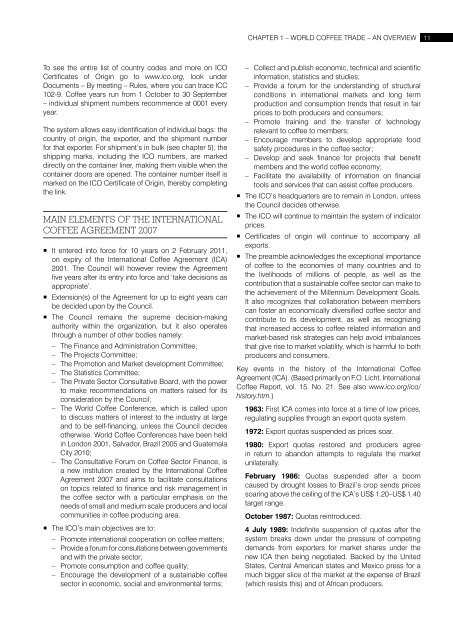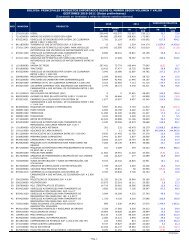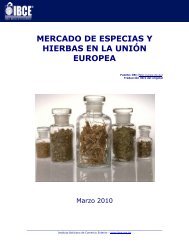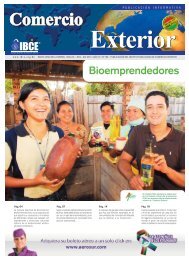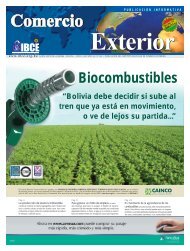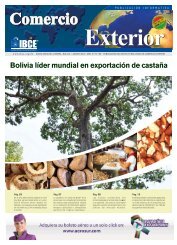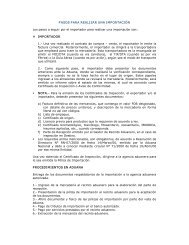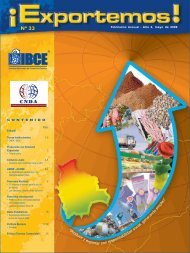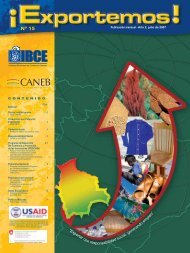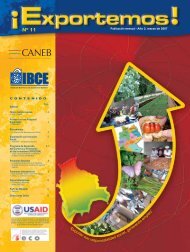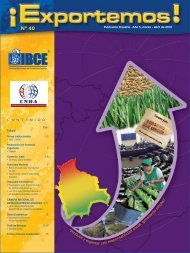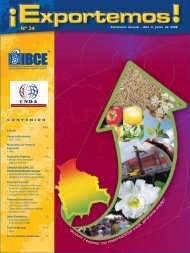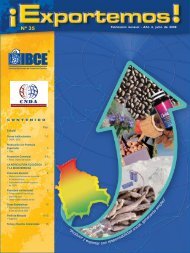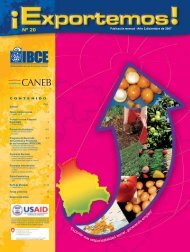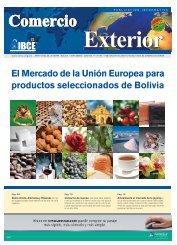The Coffee Exporter's Guide - International Trade Centre
The Coffee Exporter's Guide - International Trade Centre
The Coffee Exporter's Guide - International Trade Centre
- TAGS
- www.ibce.org.bo
You also want an ePaper? Increase the reach of your titles
YUMPU automatically turns print PDFs into web optimized ePapers that Google loves.
To see the entire list of country codes and more on ICO<br />
Certifi cates of Origin go to www.ico.org, look under<br />
Documents – By meeting – Rules, where you can trace ICC<br />
102-9. <strong>Coffee</strong> years run from 1 October to 30 September<br />
– individual shipment numbers recommence at 0001 every<br />
year.<br />
<strong>The</strong> system allows easy identifi cation of individual bags: the<br />
country of origin, the exporter, and the shipment number<br />
for that exporter. For shipment’s in bulk (see chapter 5), the<br />
shipping marks, including the ICO numbers, are marked<br />
directly on the container liner, making them visible when the<br />
container doors are opened. <strong>The</strong> container number itself is<br />
marked on the ICO Certifi cate of Origin, thereby completing<br />
the link.<br />
MAIN ELEMENTS OF THE INTERNATIONAL<br />
COFFEE AGREEMENT 2007<br />
� It entered into force for 10 years on 2 February 2011,<br />
on expiry of the <strong>International</strong> <strong>Coffee</strong> Agreement (ICA)<br />
2001. <strong>The</strong> Council will however review the Agreement<br />
fi ve years after its entry into force and ‘take decisions as<br />
appropriate’.<br />
� Extension(s) of the Agreement for up to eight years can<br />
be decided upon by the Council.<br />
� <strong>The</strong> Council remains the supreme decision-making<br />
authority within the organization, but it also operates<br />
through a number of other bodies namely:<br />
– <strong>The</strong> Finance and Administration Committee;<br />
– <strong>The</strong> Projects Committee;<br />
– <strong>The</strong> Promotion and Market development Committee;<br />
– <strong>The</strong> Statistics Committee;<br />
– <strong>The</strong> Private Sector Consultative Board, with the power<br />
to make recommendations on matters raised for its<br />
consideration by the Council;<br />
– <strong>The</strong> World <strong>Coffee</strong> Conference, which is called upon<br />
to discuss matters of interest to the industry at large<br />
and to be self-fi nancing, unless the Council decides<br />
otherwise. World <strong>Coffee</strong> Conferences have been held<br />
in London 2001, Salvador, Brazil 2005 and Guatemala<br />
City 2010;<br />
– <strong>The</strong> Consultative Forum on <strong>Coffee</strong> Sector Finance, is<br />
a new institution created by the <strong>International</strong> <strong>Coffee</strong><br />
Agreement 2007 and aims to facilitate consultations<br />
on topics related to fi nance and risk management in<br />
the coffee sector with a particular emphasis on the<br />
needs of small and medium scale producers and local<br />
communities in coffee producing area.<br />
� <strong>The</strong> ICO’s main objectives are to:<br />
– Promote international cooperation on coffee matters;<br />
– Provide a forum for consultations between governments<br />
and with the private sector;<br />
– Promote consumption and coffee quality;<br />
– Encourage the development of a sustainable coffee<br />
sector in economic, social and environmental terms;<br />
CHAPTER 1 – WORLD COFFEE TRADE – AN OVERVIEW 11<br />
– Collect and publish economic, technical and scientifi c<br />
information, statistics and studies;<br />
– Provide a forum for the understanding of structural<br />
conditions in international markets and long term<br />
production and consumption trends that result in fair<br />
prices to both producers and consumers;<br />
– Promote training and the transfer of technology<br />
relevant to coffee to members;<br />
– Encourage members to develop appropriate food<br />
safety procedures in the coffee sector;<br />
– Develop and seek fi nance for projects that benefi t<br />
members and the world coffee economy;<br />
– Facilitate the availability of information on fi nancial<br />
tools and services that can assist coffee producers.<br />
� <strong>The</strong> ICO’s headquarters are to remain in London, unless<br />
the Council decides otherwise.<br />
� <strong>The</strong> ICO will continue to maintain the system of indicator<br />
prices.<br />
� Certifi cates of origin will continue to accompany all<br />
exports.<br />
� <strong>The</strong> preamble acknowledges the exceptional importance<br />
of coffee to the economies of many countries and to<br />
the livelihoods of millions of people, as well as the<br />
contribution that a sustainable coffee sector can make to<br />
the achievement of the Millennium Development Goals.<br />
It also recognizes that collaboration between members<br />
can foster an economically diversifi ed coffee sector and<br />
contribute to its development, as well as recognizing<br />
that increased access to coffee related information and<br />
market-based risk strategies can help avoid imbalances<br />
that give rise to market volatility, which is harmful to both<br />
producers and consumers.<br />
Key events in the history of the <strong>International</strong> <strong>Coffee</strong><br />
Agreement (ICA). (Based primarily on F.O. Licht. <strong>International</strong><br />
<strong>Coffee</strong> Report, vol. 15. No. 21. See also www.ico.org/ico/<br />
history.htm.)<br />
1963: First ICA comes into force at a time of low prices,<br />
regulating supplies through an export quota system.<br />
1972: Export quotas suspended as prices soar.<br />
1980: Export quotas restored and producers agree<br />
in return to abandon attempts to regulate the market<br />
unilaterally.<br />
February 1986: Quotas suspended after a boom<br />
caused by drought losses to Brazil’s crop sends prices<br />
soaring above the ceiling of the ICA’s US$ 1.20–US$ 1.40<br />
target range.<br />
October 1987: Quotas reintroduced.<br />
4 July 1989: Indefi nite suspension of quotas after the<br />
system breaks down under the pressure of competing<br />
demands from exporters for market shares under the<br />
new ICA then being negotiated. Backed by the United<br />
States, Central American states and Mexico press for a<br />
much bigger slice of the market at the expense of Brazil<br />
(which resists this) and of African producers.


